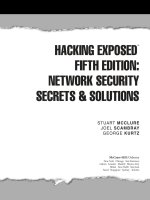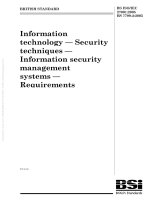Ebook Information security management principles (second edition, Volume 6): Part 2
Bạn đang xem bản rút gọn của tài liệu. Xem và tải ngay bản đầy đủ của tài liệu tại đây (2.6 MB, 119 trang )
5TECHNICALSECURITYCONTROLS
In this chapter we discuss in more detail the technical controls that are
implemented to provide protection against security incidents. This includes the
detection,preventionandmitigationofsuchincidents.
Therearethreemaintypesofcontrol:
physical,forexamplelocksondoorsandsecurecabinets;
procedural,forexamplecheckingreferencesforjobapplicants;
product and technical controls, for example passwords or
encryption.
Of these, the product and technical controls are perhaps the most important in
terms of information security since they are often the last barrier to illegal or
unauthorized activity. As mentioned in Chapter 4, we deal here with mainly
genericcontrolsbecausethemoredetailedinformationaboutspecificcontrolsis
outsidethescopeofthispublication.
PROTECTIONFROMMALICIOUSSOFTWARE
Learningoutcomes
The intention of this section is to provide the reader with the basic knowledge
needed to put in place effective controls to manage the risks from malicious
software. Once completed, the reader should have an understanding of each of
thefollowingconcepts.
Typesofmalicioussoftware
Thetopicofmalicioussoftwareisverylargeandcouldeasilyfillabookofits
own. In this section the barest basics are described and enough information is
given to allow the reader to continue their studies elsewhere if they so wish.
Malware (from MALicious softWARE), as it is often known, is one of the
largest threats to the users and managers of information systems. An
understandingofthecapabilitiesofmalwareandthosewhowriteit,alongwith
the controls that are needed to counter that threat, are essential for most
informationassurancepractitioners.
Asimpledefinitionofmalwarewouldbesomethinglike:
An unauthorised piece of code that installs and runs itself on a
computer without the knowledge or permission of the owner. It then
conducts data processing and other operations that benefit the
originator,usuallyattheexpenseofthesystemusersortherecipientof
theoutputfromthemalware.
Thetraditionalideaofmalwareisthevirusthatinfectsyourcomputer,attempts
tospreaditselftoothers,thentrashesthecontentsofyourharddiskordisplaysa
messagetoshowthatitwassuccessfulininfectingyourmachine.Alotofthe
early malware did just this. Things have moved on, however, and the main
emphasis now is not on ‘spreading chaos while gaining kudos’, it is about
money.TheFBIannouncedthat,forthefirsttimeeverin2006,organisedcrime
gangs in America made more money from cybercrime than they did from
dealingindrugs.ItisbigbusinessinmanypartsofeasternEuropeandthefar
easttoo.Thechancesofbeingcaughtaremuchlowerthanfordrugsoperations
andthesentences,ifconvicted,tendtobemuchshorter.
The old malware writers wanted you to know that they had succeeded in
infectingyourmachine;nowitischangedroundcompletely.Thevastmajority
of modern writers know that if you realise you have an infected system they
havefailed,becauseyouwilldisinfectit.
Modernmalwarecanbesplitintothefollowingmajorcategoriesdependingon
theirpayload.
Viruses.Thesecannotspreadontheirown.Theyneedtobeattachedtoanother
piece of data or program to reach and infect another computer. They are often
triggeredbyopeninganemailattachmentorexecutableorreceivedbyemailor
onremovablemediasuchasCDorUSBstick.
Worms.Thedifferencebetweenawormandavirusisthatwormscontainthe
code needed to spread themselves without any user action. They will seek out
othercomputersonanynetworkstheycanfindandcanspreadveryquickly.Itis
estimatedthattheSlammerworminfected90percentoftheworld’svulnerable
computerswithin10minutesofbeingreleased.
Rootkits.Thesearecomplexsoftwarepackagesthathijacktheoperatingsystem
and attempt to make themselves invisible both to the user and to the software
designed to find and remove malware. They are insidious in that they still
performalltasksthattheuserrequests,buttheyoftenmakecopiesofsensitive
datasuchaspasswords,accountdetailsandloginsandthensendthemtoanother
computer,oftentoenablefinancialfraudsuchasidentitytheft.
Back doors. The idea of the back door is to do just as it says. It provides a
meansforathirdpartytoaccessthecomputeranduseitfortheirownpurposes
withouthavingtocarryoutthenormalauthenticationchecks.Thesecanbeused
to turn the computer into a ‘bot’ (short for robot) that is effectively under the
remote control (usually via IRC – Internet Relay Chat – channels) of the
attacker. It can then be used to distribute spam or act as part of a distributed
DenialofServiceattackonathirdpartythatcannoteasilyorquicklybetraced
backtotheattacker.
Spyware. A common example of this is the use of cookies by websites. Some
are designed to be permanent and to track and report the web usage back to a
thirdpartywithouttheknowledgeoftheuser.Theycanalsologkeystrokesand
look for specific information such as bank account or auction site login
credentials. They have been known to install diallers that call premium rate
numbers (on modem-connected computers) to generate revenue for the
perpetrators.Thesecanalsobeinstalledbysoftwarethatperformsalegitimate
service, and freeware is often offered as a means of getting a user to install
spyware.
Trojans. The Trojan is the hackers’ ‘weapon of choice’ today. Far more
successful attacks use Trojans than any other attack vector. These are often
disguisedasanotherpieceofsoftwareorarehiddeninsidecompromisedcopies
orotherprogramsthatusersareluredintodownloadingandrunning.Theyoften
successfullyavoidsecuritycountermeasuresbecauseuserstendtohaveaccounts
withadministratorprivilegesthatallowtheTrojantorun.
Another very successful infection route is through compromised websites. It is
estimatedthatoneinthreewebsitescontainsmalwareofsomesort.Trojanscan
downloadthemselveswithouttheuserhavingtoclickonanybuttonsorlinkson
thepage.Simplygoingtoaninfectedwebpagecanbeenough.Moreandmore
groups,criminalandotherwise,arewritingincreasinglysophisticatedTrojansto
attackcomputersinordertoextractdata,particularlyviawebprotocols,where
the malware scanning technology is often much weaker than the email
countermeasures.
Activecontent.ThisisthemeansbywhichaTrojanisoftendownloadedtoa
computer running the viewing browser. Modern web applications use active
codesuchasFlash,Java,ActiveXandevenmimeheaderstoperformcomplex
taskswithinthewebpageto‘enhancetheuserexperience’.Thereisnoquestion
that they are good at this, but they are also good at installing malware on the
targetcomputer.Iftherightlevelofsecurityisnotsetinthebrowserpolicies,
the compromised code will install and run itself on the target without the user
havinganyknowledgeofithappening.Atypicalattackiswhereabanneradvert
runsonawell-respectedandheavilyusedwebsite,withthecodeforthebanner
beingsuppliedbyathird-partyadvertiser.Theattackersubvertsthethirdparty
and adds the Trojan into the banner code. People view the website, thinking it
trustworthybecauseofthereputationoftheorganisation,littlerealisingthatthe
advertisinghostedthereisbusytryingtoinfecttheircomputer.Thepayloadof
an active content/Trojan can be any of the forms of malware described in this
section.
Whatever the type, detecting a piece of malware on a computer is a cause for
concern and should be investigated without delay. It should also be noted that
malware is actively and very widely spread; it is not a case of if you receive
somemalware,butwhenandhowoften.Itisalmostinevitable.
Zerodayexploits
Nomatterhowgoodandcomprehensivethedefencesthatareinplace,thereis
alwaysapossibilitythatanewformofattackcangetthroughthem.
Hackerstalkabout‘zerodayexploits’.Theseareonesthathaveyettocometo
the attention of the companies selling anti-virus and firewall products, so they
have not issued an update to detect and remove them. In theory these exploits
cangetpastthescanningenginesbecausetheyarenotonthe‘stop’listthatthe
updates contain. Some products are better than others in spotting types of
behaviourandtheiranalyticaltoolscanidentifymanynewversionsofmalware
becausetheyexhibitbehaviourthatisknowntobeunacceptableorhassimilar
code to that found in other known malware. There is even a trade in zero day
exploits, with hackers selling the knowledge to others. Some zero day exploits
forthelatestversionofaverywell-knownPCoperatingsystemwereonsalefor
US$400notlongafterthebetaversionwasreleased.
Routesofinfection
Most of the routes have already been mentioned in passing but a more
comprehensivedescriptionisprovidedhere.
Infected media. Any piece of media that has been out of your control or
supervisionshouldbeconsideredsuspect–CD,DVD,USBstickandsoon.It
shouldbescannedformalware,ideallyonastand-alone,‘sheep-dip’computer
beforebeingallowedintoanoperationalcomputer.Itmayhavebeeninfectedby
anysystemwithwhichithasinteractedbeforeitreachesyoursystem.EvenCDs
that come with a magazine or as part of a special promotion should not be
trusted.Donotassumetheyhavebeenproperlycheckedbeforemassproduction.
These have been issued containing malware on more than one occasion in the
past,causingmuchembarrassmentfortheorganisationgivingthemaway.USB
sticksareanothersourceofinfection.Malwarecanusethemtotravelfromone
systemtoanother.
Themostcommonroutestodayareviaemail,asanattachmentoramacroina
document or even disguised as another file type, and through websites, as
describedabove.Wormscanpropagateacrossnetworks,wideorlocalarea,and
mayspreadthroughunprotectedsystems.
It is also possible for malware to infect your system through a wireless
networking connection, Bluetooth or infrared port. Do not have these enabled
unless you require them at the time and have a malware scanning application
thatprotectsthoseportsaswellasthestandardones.Ifthesefunctionsarenever
used,don’teveninstallthedevicedriversforthemifyoucanavoidit.
Smartphonesandtheincreasinglycomplexsoftwareavailableforthesetypesof
devices, be they phones, MP3 players, tablets, iPads or similar, all have the
capacity to be infected, some more easily than others. The idea that any one
operatingsystemissecurehasalsobeenshowntobefalseinrecentyears.The
attractiveness of infecting one operating system or manufacturer’s goods over
anotherisoftensimplyamatterofprice–isitworthwhiletoputintheeffortto
infectthistypeofdevice?
With an increase in the numbers of staff being allowed to ‘bring your own
device’ (BYOD), where staff may use their own technology to undertake their
work, there is also an increase in the risk to corporate IT infrastructures. The
detailofprovidingsecurityforthesesystemsisbeyondthescopeofthisbook,
butitcanbeverydemandingandexpensive.Dependingonthelevelofsecurity
required and the risk appetite of the company (how safe your company’s
informationneedstobe),theremaybeadecisiontobemadewhetherornotto
allowthesedevicestobeusedatallforanyofficialbusinesspurpose.
Malwarecountermeasures
The countermeasures required to detect and defeat malware depend on the
configurationofthesystemsandnetworkstobedefendedandcontinuallyneed
tobeupdatedtodealwiththelatestthreats.Asinglecomputer,connectedtoa
broadbandconnectionathome,isverydifferentfromaglobalcorporatenetwork
orasmallorganisation.
Evenforthesingleuser,becauseofthedifferentpossibleroutesofinfection,a
basic anti-virus package is not enough. The user requires a personal firewall
packagetoo.ThiswillprovideadefenceagainstwormsandwebTrojans.Goodqualityproductsalsocontainaprofilingandaccesscontroltool.Wheninstalled
they scan for existing malware and remove it, then build a profile of all the
existing executables, putting them on a ‘whitelist’ of allowed products. Any
new,unknownexecutableoractivecontentcanbeblockedfromrunningunless
manuallyapprovedbytheuserastheresultofapromptonthescreen.
Inanidealworld,largeorganisationsthathaveseparatesystemstoreceiveemail
and perform web browsing will need products or services for each system, for
example:
content scanning for web traffic and some means of controlling
webaccesstostopprohibitedsitesfrombeingaccessed;
emailcontentandsourcecheckingsoftware;
firewallsthatblockportsandcheckcontent;
networkintrusiondetectionorpreventionsystems;
‘Sheep-dip’malwarescannersforuntrustedmedia;
personal firewall or application control software on individual
systemsincludingcheckingfileswhentheyareaccessed;
useofmanagedservicesproviderstoscanmailandwebtraffic–
inboundandoutbound.
It is not the place of this textbook to recommend specific manufacturers’
products,butitcanlistfunctionalitythatusersshouldcheckforwhenacquiring
suchcountermeasures:
highdegreeofeffectivenessindetectingandremovingmalware
–readindependentreviews;
frequent and easy-to-deploy updates to signatures and scanning
engines;
abilitytocreateandmaintainawhitelistofacceptedexecutables,
activecodeandopennetworkports;
support from a reputable company that can provide prompt
updatestomajorthreatsandsupport;
minimalimpactonoperationofthesystems.
Taking regular secure backups is also a good way of countering malware. If
somethingdoesgetinandcompromisestheintegrityoravailabilityofdata,itis
possible to restore from the last good backup to minimise the impact upon the
organisation.UseoftheGrandfather-Father-Son(GFS)approach(maintainingat
leastthreegenerationsofthebacked-updata)ishighlyrecommendedtoprovide
defenceindepthandallowrollbacktodatesfurtherbackintimeifnecessary.
It is important to remember that there is a never-ending ‘arms race’ between
malware writers and the developers of the countermeasures. The hackers are
continuallydevelopingnewwaystoinfectsystems–newtypesofcodeandnew
routes of infection. Some malware is quite sophisticated and can even defend
itself,tosomedegree,againstcountermeasuresandothermalware.
Methodsofcontrol
There are several approaches to controlling malware that need to be
implemented at the same time if an organisation is to manage the associated
risks sucessfully. The first one is not always obvious and doesn’t relate to any
formofspecialistmalwareapplication.Thisapproachispatching.Theoperating
system or application that does not contain any bugs or vulnerabilities has not
yet been written. Patches and upgrades are released quite frequently and every
organisation should test and install patches at the earliest opportunity. Hackers
keep a close eye on patch releases and the more capable ones will reverseengineer the patch to identify the weakness it resolves. They then write or
modify malware to take advantage of that weakness. The Slammer worm took
advantage of a weakness for which a patch had been issued over eight months
previously.Thewormwassosuccessfulbecausealotoforganisationshadnot
appliedthepatch.Thetimefromapatchbeingreleasedoravulnerabilitybeing
describedtoanexploitappearing‘inthewild’isnowdowntoaslittleasthree
days. Organisations must not only apply patches, but also do it promptly to
provide adequate protection from new malware. User awareness is important
too.Usersthathavebeeneducatedaboutthethreatsarelesslikelytoclickona
suspect link or fall for a social engineering attack that tries to trick them into
loadingmalware.
Another approach is to ‘harden’ the operating system by not installing
unnecessary features or applications and to ensure that default passwords and
open configurations are not used. This is not the place to discuss the detail of
howtoperformthesetasks,whichisbestlefttoexperts.Sufficeittosaythatan
operating system installed using all the default settings recommended by the
manufacturerisoftenveryeasytocompromiseeithermanuallyorbymalware.
Afurtherapproachhasalreadybeenmentioned–useofanti-virusandpersonal
firewall software. Some operating systems come with versions of firewall and
malware-removal bundled in as part of the product. Experience and much
independent testing have shown that these are often not necessarily the best
products to use. Larger organisations need to investigate and select specialist
productstoprotecthigh-bandwidthroutesinandoutoftheorganisation,suchas
emailandwebinterfaces.Goodfirewallproductsalsocontainmalware-checking
applications, and specialist appliances are available to monitor activity on
internalnetworks.
The last, but equally important, approach is to harden the settings in the web
browser in use. By default these often have much too low a level of security,
allowing active code to run by default and accepting cookies from any source.
Change the settings to only accept cookies from the original source and either
disableactivecodecompletelyorattheveryleastprompttheusertoauthorisea
pieceofcodetoruneachtimeittriestodosointhebrowser.
Noneoftheseproductsareofmuchuseunlesstheyarekeptuptodate.Many
new items of malware are identified every day. The application and product
providers issue regular updates to the signature files and sometimes to the
scanning engines themselves. The same approach as for patching is required:
download the updates and install them promptly to benefit from the protection
they offer against new threats. Good products are capable of automatically
distributingupdatesacrossthenetworktoallclients,savingtimeandresources.
TheofficersofGANThavedecidedthattheyneedtoestablishabetter
meansofcommunicatingamongthemselvesandwiththemembersof
the society. Some members report that they have been targeted by
personssendingthemmalwareinemailsorattemptingtoextractdata
abouttoadpopulations.Theofficershavenoknowledgeofthisareaof
computing and need advice on how to protect their systems, at home
andintheGANToffice,againstmalware.
The loss or unauthorised disclosure of sensitive membership or toad
population data would be embarrassing and potentially harmful to
humanandamphibianalike.
ACTIVITY5.1
What advice would you give to the society with regard to the
countermeasures they need in order to provide an adequate level of
protectionfrommalware?
NETWORKSANDCOMMUNICATIONS
Learningoutcomes
Theintentionofthissectionistoprovidethereaderwiththebasicknowledgeto
understand the issues that organisations should take into consideration when
identifying and managing the security risks to their networks and
communicationslinks.
Entrypointsinnetworksandprinciplesofauthentication
techniques
Thereisanoldjokethat‘ifitwasn’tfortheuserswewouldn’tneedsecurity’.
That can equally apply to the network and any connections to it. Not having a
networkwouldreducethesecurityrequirementbyafactoroften.Thenetwork
andcommunicationslinksexisttomakethesystemsconnectedtothemavailable
to authorised users. Unfortunately it also makes them available to all the
unauthorisedones.Ifthereisaninternetconnectionsomewhere,thenthereare
morethantwoandahalfbillionpotentialunauthorisedusers.Experienceshows
usthatsomeofthemareuptonogoodandwilltrytocompromiseyournetwork
insomeway.Evenifit’sonlyatinyfractionofonepercent,thatisstillavery
bignumberwhenitispartoftwoandahalfbillion.
Anylocation,logicalorphysical,fromwhichauserordevicecangainaccessto
a network is considered an entry point. Where the whole system is hard-wired
thesearefairlyeasytodefine.Theinclude,butarenotlimitedto:
aterminalorPCinanoffice;
aconsoleonaserver;
abroadbandconnection;
a router for a connection from another network – internal or
external;
a firewall protecting a connection from another network –
internalorexternal.
If any aspect of wireless networking is involved, the perimeters become much
hardertodefinebecausetheabilityofanattackertouseadvancedradiodevices
greatly increases the effective range from which they can access the network.
The existence of a Wireless Access Point (WAP) within a network will add
enormously to the challenges of securing the network against unauthorised
access.ThefactthatthehardwareisrelativelycheapandinstallingaWAPhas
beenmadesoeasypresentstwomorechallenges:
users can buy and install their own hardware without the
knowledgeoftheITdepartment;
thedefaultconfigurationsarealmostalwaysinsecure,withopen
settingsandwidelyknowndefaultpasswords.
Anotherinsidiousthreatisthatotherorganisationsincloseproximitymayalso
beusingwirelessnetworkingandusersmayaccidentallyorintentionallyconnect
tothewrongnetwork.Thereisarealriskofsensitivedatabeingcompromised
by this kind of activity. It is also possible for an attacker to use a wireless
connection while sitting in their car, or a neighbouring building, to view,
download or upload unacceptable content. This could lead to a visit from the
police with a search warrant for activities that were not conducted by an
employeeandofwhichtheorganisationhasnoknowledge.Itisusuallytoolate
totryandexplaintotheMDaftertheeventhasbeenreportedinthepapers.
Theprincipleofauthenticatingtoanetworkisverysimilartothatdescribedin
thesectiononuseraccesscontrolsforidentifyingandconnectingtoacomputer.
It may even be that a single sign-on system is in use that authenticates the
identity of the user to the network and then grants appropriate privileges and
accessrightsforallthesystemsforwhichthatuserhasauthority.
There are protocols designed specifically for centralised access control (e.g.
Radius,TACACS,KerberosandDiameter)thatworkwellfornetworks.These
provideauthenticationoftheuserandsoftwareonadedicatedserver.Thismay
bejustusernameandpasswordoritmayinvolvesomekindoftokenandcode
inputorpossiblyachallenge-responsemechanism.
Partitioningnetworks
Partitioning a network is another way of protecting essential systems. It is the
sameprincipleasphysicalaccesscontroltolimitaccesstosensitiveareasofthe
officeorthe‘need-to-know’principlewhereonlycertainpeopleareallowedto
haveknowledgeofsomeinformationtomanagetheriskstoit.
Therulesonbusinessgovernanceandseparationofroleswithinsomebusiness
sectors, especially finance, require complete data separation to defend against
insidertradingandaccusationsofmarketmanipulation.Networkpartitionscan
providethisfunctiontoo.
Byusinganetwork‘sniffer’anattackercanpotentiallyrecordallofthetraffic
passing across a segment. The sniffer may be a hardware module or some
softwareinstalledonaworkstationorserverasaTrojantocapturedataandsend
ittotheattacker(whomaybeanemployeeorexternaltotheorganisation),for
uselater.Thisislikelytoincludesensitivedata,usernamesandpasswords.Ifthe
attacker can see the whole network they can ‘sniff’ the whole network too.
Partitioninganetworklimitstheamountofdatathatcanbeseenandmakesthe
job of an attacker much harder. It is also true that partitioning can limit the
damage done by malware. The chances are that any infection may affect only
onenetworkpartition,limitingthedamagedoneandtheeffortneededtoclean
upthesystemtorestorenormaloperations.
Without network partitions, an external attacker who defeats the perimeter
securitycanaccessanyareaofthenetworkwithlittleimpediment.Aninternal
attackerdoesn’tevenhavetobeatthedefencesbecausetheyarealreadyonthe
inside.Thedecisionabouthowmuchprotectiontooffershouldbemadethrough
ariskassessmentprocess,buttherearecertaincommonsafeguardsthatshould
beconsideredbymostorganisations.
Any connection to the outside, such as the internet, should be protected by at
least one firewall. If there is any other form of remote access, such as dial-up,
ADSLorweb-basedaccess,thentheserversshouldbelocatedinademilitarised
zone (DMZ), which sits between two firewalls. Any successful attack on the
access point through that external connection does not then immediately grant
access to the whole network. It also makes sense to locate the network
connectionforanyWiFiaccessintheDMZ,becauseitissoeasytoattack.
There are various approaches to partitioning networks, from physical cabling
separation,totheuseofVirtualPrivateNetworks(VPNs)configuredinnetwork
hardware or even protocols such as CISCO MPLS. Each has its good and bad
points, ranging from strength of security to cost. The appropriate solution will
depend on the outcome of risk assessment, risk appetite and budget. A
department or site may have an individual local area network (LAN) linked to
othersviarouterstoformawideareanetwork(WAN).
Cryptographyinnetworking
Cryptography is described in more detail in a later chapter, but some basic
concepts need to be understood now. There are two common mistakes many
peoplemakewhentheythinkofcryptography.Thefirstoneisthattheythinkit
stopspeoplefrombeingabletoseeyourdata.Thisisnotthecase.Attackerscan
stillseeyourdata,butifyouhavegotthecryptographyrightitmeanstheycan’t
understand it. The second one is that they think cryptography is only used to
provide confidentiality. Once again, this is wrong. The four main uses of
cryptographyare:
secrecy–nobodyelsecanseetheplaintext;
data integrity – the data has not been changed, deleted or
inserted;
userverification–thisisthepersontheyclaimtobe;
non-repudiation – the sender cannot later deny sending the
messageoritscontent.
Different forms of cryptographic process can be used and combined into
protocolstoperformdifferenttasks.Forexample,digitalsignaturesareaformof
cryptographyanddonotnormallyprovideconfidentiality;theirmainfunctionis
toprovidenon-repudiation.
Datatravellingacrossanetworkisobviouslyintransit,butdonotforgetthata
network provides access to data that is at rest, on a hard drive or other media.
Yourarchitecturemustprotectboth.Goodoperatingsystemsalsouseencryption
across networks, especially when sending passwords. This feature may not be
activated by default; it is always worth checking. This defends against the
captureofpasswordsbyattackerswithnetworkaccess.
ThemostobviousformofcryptographythatmostpeopleseeanduseisSecure
Sockets Layer (SSL), which provides encryption for websites, especially
ecommerce,toprotectfinancialdatasuchascreditcardnumbers.Itsoperationis
signified by the little yellow padlock symbol in browser windows. The user of
thebrowserdoesnotnormallyneedtodoanythingotherthancheckthevalidity
oftheSSLcertificatetomakesurethatitbelongstotheorganisationwithwhom
they want to do businessd. The entire configuration is done in advance by the
operatorofthewebsite.Whenauserconnectstothesite,theirbrowserandthe
website set up an SSL channel to protect the data from being read by a third
partyasittravelsacrosstheinternet.
In business, the increase in mobile working has meant that there has been a
steady rise in the need for VPNs. These are another way of encrypting
(protecting) traffic that travels over a public connection, which could be the
internetor,afixedorwirelessbroadbandconnection.Thecommonriskwithall
oftheseconnectionsisthatthedataistravellingacrossasystemthatisowned
andadministeredbypeopleunknownandthereforenotfullytrustedbytheuser.
It is also possible for a third party to compromise the channel and eavesdrop
trafficintransit.ThatiswhycryptographyisusedtocreateaVPN.Thedatapart
of the traffic is encrypted before leaving the sender until after it arrives at the
receiver,leavingtheaddresspartintheclearsothatitcanbereadandroutedby
thepublicnetwork.
ThesystemusesVPNclientsoftwareontheremotesystemtocontactthehost
server over a public channel. The user has to complete identification and
authentication procedures in the usual manner. Once the identification and
authentication(ID&A)iscompletethehostandclientagreeonasecretkeyand
theencryptionprocessstarts.Fromthenonthebodyofthedataisencryptedand
protected from eavesdroppers. The concept of the VPN can also be used to
separateinternalnetworktraffic,asdescribedintheprevioussection,toensureit
cannotbereadbythosewithoutaneedtoknow.
Controlofthird-partyaccess
Theconceptofallowingthirdpartyaccesstotheorganisationalnetworkisnota
newone.Justthinkoftheoriginaluses–aremoteconnectionfromasupplier,
used to support hardware or software remotely. In this day and age, it’s more
likely to allow some form of electronic data interchange (EDI) to improve
efficiency or speed up business processes. A classic example would be a
customerwhousesajust-in-timeapproachtomanufacturing,placingelectronic
orderswithsuppliersforcarefullytimeddeliveriesofcomponents.
ThislinkmaybeovertheinternetviasomekindofVPN,oritmaybethrougha
privatelink.Therewillcertainlybeaneedtopartitionthenetworktolimitthe
areas that the third party can access, because of the need to manage risks to
informationassets.Itisanotherexampleofthe‘need-to-know’principle.They
may be a business partner but they do not need to know much about your
organisation that isn’t in the public domain. There may even be regulatory
requirements governing this access (covered in the next section). The primary
concernistoensurethattheaccesspointcanonlybeusedbyauthorisedpersons
orapplicationsfromwithinthethirdparty.Identificationandauthenticationare
still required to stop attacks across the link by third-party staff or anyone who
manages to find a way to connect into the link. The standard approach to
protecting the link itself is cryptography, such as a VPN. A good design will
normallyhavethelinktothethirdpartylocatedwithinaDMZ,protectedbya
firewall from the outside world and another one that only allows permitted
trafficthroughintotheorganisation’sinnernetworktoaccessaspecifiedserver
andviceversa.
Networkusagepolicy
Thenetworkusagepolicydocumentexiststodefinethepurposesforwhichthe
networkmay,andmaynot,beused.Itwillalsodefinetheindividualsandroles
whoareallowedtouseitandtheofficiallineonaccesscontrol.Thiswillinclude
definitions of the user profile for each role – privileges, password lengths and
strengths,renewalperiodandsoon.
Intrusionmonitoringanddetection
Ithasalreadybeenmentionedthatnetworksareoftenattackedfromtheoutside
byunauthorisedusersorbyauthoriseduserswithintheorganisationattempting
to perform tasks for which they are not authorised. It is important that the
networkhassomemeansofdetectingandreportingontheseattacks.Thisispart
oftherolethatisgenerallyreferredtoas‘protectivemonitoring’.Thefirsttask
istoensurethatallrelevantlogdataisrecordedsecurelyandinsuchawaythat
anattackercannotchangeordeletetheinformationinordertocovertheirtracks
from investigators and auditors. This can provide evidence of what happened
and be used to identify any damage done and how it was achieved. The data
mustbeperiodicallyreviewedinordertoidentifyanyunauthorisedactivity.Log
datathatisneverexaminedisofverylittlevalueandnotmuchofadeterrent.
Thesecondtaskistolookforpatternsofbehaviourthatindicatesomekindof
attack. This can be hardware- or software-based and can provide automated
alertsformanyoftheattackforms.Thereareseveraldifferentsolutionsonthe
market.ManyofthemusetheSNORTengine(anopensourcenetworkintrusion
prevention and detection system), which is a publicly available shareware
product. It is signature-based and easily updated. None of the products are
infallible,butthegoodoneswilldetectandstopthevastmajorityofattacks.
Itshouldbesaidthatthisarearequiresgoodknowledgeandexperienceifitisto
beperformedwell.Thereisnosubstituteforhoursspentstudyingthissubject.
Coursesandexternalwebsitescanbeusedtogainknowledgeandkeepcurrent
withnewtechniques.Knowyourenemyandtheirmodusoperandi.
Vulnerabilityanalysisandpenetrationtesting
An even more demanding task is that of analysing systems for vulnerabilities
and performing penetration tests (pen tests). Only the most skilled and
dependableofspecialistsshouldbeallowedtoconductthiskindofwork,asitis
veryeasytoadverselyaffecttheavailabilityofsystemsandthedataitselfifthey
don’thavetherightknowledgeortools.Therearealsosignificantlegalissuesto
consider before undertaking any form of ‘pen testing’. Good ‘pen testers’ are
oftenconsideredtobeamongsttheeliteofinformationassuranceprofessionals.
Vulnerability analysis is the process of examining the network for any
vulnerabilities that could increase the frequency or impact of any threat. An
example would be a modem connected to the network, making it easy for an
attackertofindawayin,using‘wardialling’,whichistoringeverynumberthe
company has and see which ones have a modem attached or which will allow
accesstothemaintelephoneexchangecontrolsystem.Attacksarelikelytobe
muchmorefrequentbecauseamodemsuchasthisiseasytofind.Thistaskis
bestdonebysomeonewhoknowsthenetworkinconjunctionwithsomeonewho
understandssecurity.
Penetration tests are sometimes referred to as ‘ethical hacking’ because the
testerswillusemanyofthetechniquesthatwouldbeusedbyahackerinorder
to identify any weaknesses in the network. Vulnerabilities are often not just
weaknesses that allow access to data, but the ability to cause denial of service
too. Owing to the possible implications, there is a lot of paperwork to be
completed before the work can start, including a detailed briefing document
defining:
thetermsofengagement;
whatisinandoutofscopefortesting;
acceptablelevelsofdisruption(ifany);
levelofsocialengineeringallowedorexpected;
toolsandtechniquestobeused;
format of reporting and secure deletion of data obtained during
thetest;
actionuponfindingavulnerability–majorandminor;
useofanon-disclosureagreement.
Anyonewhohasnotspecifiedormanagedapentestbeforeisstronglyadvised
toseekadviceandguidancefromsomeonewhohas.
Securenetworkmanagement
Thebasictechnicalelementsfornetworksecurityhavealreadybeendiscussed,
so it is time that network management was considered from the perspective of
the department manager and senior management. The task of managing a
network securely is one of the most crucial aspects of IT service delivery. No
network means no communications, no security means you are open to loss of
data,intellectualproperty,revenueandreputation.Anyoneofthesecanputan
organisation out of business; an insecure network can easily cause several of
theseatonce.
Somebusinesssectorsrequireminimumstandardsthroughlegalandregulatory
controls. Others choose to implement them to comply with standards such as
ISO 27001. Network management can play a major role in managing risk and
improvingresilienceforbusinesscontinuity.
In order to manage its business effectively, any organisation needs to have
informationaboutitsinfrastructure,especially:
assets–physicalandlogical;
architecture–systemsintegrationandinterconnectivity;
risks–threats,impactsandvulnerabilities;
countermeasures–logicalandphysicaldefences.
Inaddition,agoodmanagementteamwillunderstand:
businessprocessesthattheITsystemssupportandservice;
organisationalpoliciesforIT,qualityandconductofoperations;
proceduresorprocessesforalltasks;
need for effective communication routes within the IT
departmentandwithotherdepartments.
Ifthisinformationdoesn’texist,workwillberequiredtocreateordevelopthem
inagreementwithallthebusinessareasandthentoimplementandoperatethem.
IdeallythisshouldbedonetoarecognisedframeworkliketheISO/IEC27000
series, the IT Infrastructure Library (ITIL), ISO 9001 or the standard for the
relevantindustrysector.
ItisusefultofollowthePlan–Do–Check–Actmodel:
Planyouractions;
Dothem;
Checkyouhavedonethembyauditing;
Act upon your findings to improve the whole system. Then go
backtoPlanandrepeat…
Don’t forget the principle that management of anything requires metrics; you
can’t manage effectively what you can’t measure – how do you know it is
working,orhowwell?Networksarenodifferent.Decideonhowsecureitneeds
tobeandhowyouwillknowwhenyouachieveit.Monitorandreportregularly
tojustifyyourbudgetandteam.
ThesuccessofGANThasledtotheorganisationgrowinginsizeand
the recruitment of a team of wildlife surveyors to look for the toads
acrossthecountry.Thesepeopleareoutinthefieldandneedremote
accesstotheITsystemsforreferenceandreportingpurposes.
In addition, there will be a national campaign to get members of the
publictoreportsightingsthroughawebsiteintowhichtheywillenter
data.Accesstothismustbesecureenoughtostopitactingasthestart
pointforaremoteattack,yetallowanyonetointeractwithittoinput
validdata.
This requires a new network structure and remote access capability –
broadband,dial-upandweb-basedmethodswillallberequired.
ACTIVITY5.2
Oneofthedirectorshasbeentoldabouttheabilitytoconnectintothe
officefromhomebyafriendinthepub,andwantstobeabletodothe
same for GANT. How would you explain the security issues that
surroundtheuseofremoteworkingtohim?
ACTIVITY5.3
Thereareconcernsthatthenetworkisbeingaccessedbypeoplewho
do not have the necessary authorisation. How would you identify the
rightplacetoinstallanintrusiondetectionsystemanditssensors?
ACTIVITY5.4
GANT has been approached by the directors of the Society for the
ListingofUndiscoveredGastropods(SLUG),whoaresuggestingthat
theirsurveyteamscouldworkinconjunctionwiththoseofGANTto
cover more ground. How would you design the security architecture
foradataconnectionbetweenthetwoorganisations?
EXTERNALSERVICES
Learningoutcomes
Theintentionofthissectionistoprovidethereaderwithanunderstandingofthe
securityissuessurroundingservicesthatusethenetwork,whichareoftenbought
infromexternalsuppliers.
Securingreal-timeservices
The rapid rise in popularity of services such as Instant Messenger (IM) and
video-conferencing has added another dimension to the challenges facing
informationsecuritymanagers.TherearealreadyexamplesofIMbeingused:
toextractdata;
toinsertmalwareontonetworks;
asachannelforphishingattacks;
for unauthorised purposes leading to legal action against the
perpetrators.
Video-conferencing isn’t necessarily quite as vulnerable. Many organisations
stilluseseparateISDNorotherdataconnectionsthatarenotlinkedtotheirdata
networks,butthedatacanstillbethesubjectofeavesdropping,leadingtoaloss
ofconfidentiality.Systemsusingwebcamsorsharingdataconnectionshavethe
samerisksandthreatsasthedatachannel,andcanbeusedasaneasybackdoor
intothenetworkifnotproperlysegregatedandprotected.
Otherreal-timeservices,suchasordinarytelephony,VoiceOverIP(VOIP)and
Closed-CircuitTV(CCTV)feeds,arealsopossibleavenuesofattack.VOIPis
especially vulnerable if it is integrated into a single messaging system. Those
with data connections can be used as a route into the organisation’s data
networks. Ordinary telephone exchange systems can be the subject of various
technicalattacks(someofwhichareknown,suchasphreakinganddial-through
fraud),leadingtolossesinthemillionsiftheyarenotconfigured,protectedand
monitoredeffectively.Justbecauseitisn’tlikeotherdataformats,indocuments
forexample,doesnotmeanitwon’tbeattacked.Theenterprisingattackerhas
knownforalongtimethatanythingrelatedtotelephonyisvulnerabletoattack.
Allyouhavetodoisfindtherightnumber,dialitandyouhaveaconnection.
Quiteoftenattackerswilluse‘wardialling’,whichcanalsobeausefultacticfor
thesecuritymanager;securityauditorshavequiteoftenusedthistechniqueand
found unauthorised modems, connected by users, that the IT department knew
nothing about. However, dial-in modems and ISDN connections are much less
commonsincetheintroductionofbroadbandinternetconnectivity.
Sincemanyoftheseservicesarequitenew,thetechnologyavailabletoprotect
themisalsonewandmaynotbeasmatureasproductsthatprotectagainstother
threats. That means they may still have weaknesses that can be exploited.
Attackerscouldwelltargettheseasbeingtheweakestspotinthedefencesofan
organisation.
Securingdataexchange
Theexchangeofdataoverthenetworkneedstobeprotectedagainstthreatsto
confidentiality,integrityandavailability.Datamustarrivewithoutbeingaltered,
deleted or subjected to eavesdropping. The ability to send data whenever
requiredmustalsobemaintained.Itdoesn’tmatterwhatformthisdatatakes,the
sameprinciplesapply.Itismerelythatthecountermeasuresusedtoprotectthe
datathatwillvary.Cryptographyandsecurityprotocolscanbeusedtoperform
thisfunctionfordataintransit.Thekeyissueistoensurethatallpartiesprotect
thedatatothesamestandard.Ifonedoesnot,thentheyriskbeingidentifiedas
theeasytargetandtheadditionalprotectionattheotherlocationswillcountfor
nothing.
Thelastpointtonoteisthat,oncedataarrives,itmustbecheckedforanysigns
ofmalwareorcompromisebeforebeingallowedaccessorgivenanycredenceas
legitimate traffic. This should be conducted in the DMZ, described previously,
beforepassingthroughintotheinnernetwork.
Theprotectionofwebservicesandecommerce
In business-to-business relationships, there is normally a lower degree of risk
when electronic data interchange (EDI) occurs. A level of trust is often
established by some means before EDI begins. Security architects must
rememberthattheusersofwebservicesandecommerceareoftenmembersof
the public, and so organisations have no control over the configuration and
integrity of the PC being used to access the service being provided. It is
important, therefore, to consider the possibility of malware such as infectious
Trojansorkey-loggersbeinginstalledontheuser’sPCandtodesignsecurityto
protecttheserversprovidingthefunctionality.
There is also the obvious issue that websites are normally public facing and
therefore open to attack by anyone with an internet connection. It is estimated
that as many as one in three of all websites have been compromised with
malware. Protection must be given to stop attackers from extracting data,
enteringfalsedataandaddingtheirowncodetothesite,eitherforpropaganda
purposes or to add malware that is downloaded by any visitors. The most
obvious form of cryptography that most people see and use is Secure Sockets
Layer (SSL) (described earlier in this chapter), which provides encryption for
access to websites, (especially ecommerce), to protect financial data such as
credit card numbers. When a user connects to the site, their browser and the
website set up an SSL channel to protect the data from being read by a third
partyasittravelsacrosstheinternet.
Protectionofmobileandtelecommutingservices
Inthemodernworld,moreandmorepeoplearespendingtimeoutoftheoffice
travellingorworkingfromhome.Thisincreasehasbeenfacilitatedbythenew
technologythatallowsimprovedremoteaccess,notjustbroadbandathomebut
also in hotels, and wireless networking. The mobile phone companies also
provide services such as GPRS (GSM Packet Radio Service), 3G, HSDPA
(High-SpeedDownlinkPacketAccess),EDGE(EnhancedDataRatesforGSM
Evolution) and LTE (Long Term Evolution), which use their 2G, 3G and now
4G infrastructure to provide a high bandwidth connection to the office and the
internet.
Wehavealreadytalkedaboutsecuringthesystemsintheofficethatreceivethis
kindoftraffic,sointhissectionwewillconcentrateontheelementsthatare‘out
ontheroad’.
Thethreemainproblemsfacingassurancepractitionershereare:
Theconnectionusesnetworkinfrastructurethatdoesnotbelong
tothecompany,sotrafficcanbeviewed,alteredordeletedbyan
attacker.
The users take their IT and communications equipment away
fromcompanypremises,whereitismorevulnerabletotheft,loss
orcompromise.
Ensuring that connections are only used by authorised
employees.
Thefirstproblemcanbedefendedwithencryption.CreatingaVPNtunnelfrom
theuserdevicebacktotheofficecandefeatallbutthemostdeterminedattacker
ifitisimplementedproperly(asdescribedinsection5.2).
Thesecondchallengecanbepartlysafeguardedwithencryptiontoprotectdata
heldondevicescarriedoffsite.Ifhardwareisstolen,theattackercannotloginto
thedeviceandreadthedata,soalltheyhavestolenisadevicetoreformatand
sell,notvaluablecompanydata.Theotherpartoftheequationistomakesure
thattheusershavereceivedappropriatesecurityawarenesstrainingaboutmobile
working and that they are issued with good physical locks to secure their
equipment.Partoftheawarenesstrainingshouldbeaboutworkinginunsecured
environments; who can see your screen and paperwork or overhear your
conversations?
ThelastpartistomakesurethatanycommunicationsID&Aprocessincludesa
PINortokencode,andthatdevicescapableofremotecommunicationscanhave
theirservicedisabledquickly.Thisstopstheattackerfrombeingabletoaccess
yournetworkandfromrunningupbigbillswithyourserviceprovider.
Additionally, the ISO/IEC 27000 series of standards has been enhanced to
includeISO/IEC27010–Informationsecuritymanagementforinter-sectorand
inter-organisationalcommunications.
Secureinformationexchangewithotherorganisations
Wehavealreadydescribedtheprocessofsecuringaconnectiontoathird-party
organisation, but there are more than just the technical issues to consider. We
brieflymentionedthattheremayberegulatoryorlegalrequirementsgoverning
data interchange, and now is the time to go into more detail. The main acts to
considerintheUKare:
DataProtectionAct(DPA);
HumanRightsAct(HRA);
FinancialServicesAct(FSA);
Official Secrets Act (for government and defence projects)
(OSA);
MarketsinFinancialInstrumentsDirective(MiFID);
FreedomofInformationAct(FoIA).
Withoutdoubt,themostimportantoftheseistheDPA.Thisdefinesveryclearly
howdataistobeprotectedandused,takingintoaccounttherightsofthedata
subjectasdefinedintheDPA.Otherlegislationwillonlyrelatetothefinancial
industry(e.g.FSAandMiFID),butisveryimportanttothem.
Whentwoormoreorganisationsplantoworktogether,theimportantstartpoint
isforthoseorganisationstoagreeandsignaprotocolthatspecifiesallofthese
mattersaspartofalegallybindingcontractwhereallpartiesagreetocommon
standardsfortheprocessingandprotectionofdataprovidedtotheothers.Each
partyisthenboundunderlawtoadutyofcare.Allpartiesarethensaidtohave
shownduediligenceandhavedefenceinlaw(andusuallytherightofredress)
againstwrongdoingsbytheother.
ThedirectorsofGANThavedecidedtoopenupanecommercesiteto
sell toad-related merchandise and host a forum dedicated to
amphibians in general. This will be in partnership with several other
wildlifegroupsworkingwithotheramphibiansnativetotheUK.The
economiesofscalehavebeenrecognisedandwelcomedbyallparties.
Inordertomonitorstocklevelsandpassordersbacktotherightgroup
for dispatch, secure links and data sharing agreements need to be
created.
ACTIVITY5.5
The directors want to know how to protect GANT against malware
containedinmessagespostedtotheproposedforum.Whatwouldyou
advisethemtodo?
ACTIVITY5.6
Astheiradvisoronassurance,youneedtomakesurethatGANTdon’t
fallfouloftheDataProtectionActwhenexchanginginformationwith
theirnewpartners.Whatdoyousuggesttothem?
ACTIVITY5.7
ACTIVITY5.7
Thanks to an unexpected grant, GANT has acquired a videoconferencing system and you have been asked to link it into the
network so that anyone can watch the participants of a meeting from
theirdesk.Whatthreatsdoyouthinkyoushouldprotectagainst?
CLOUDCOMPUTING
Learningoutcomes
The intention of this section is to provide the reader with the basic knowledge
neededtounderstandtheinformationsecurityissuesfacedwhenutilisingcloud
computing facilities. Oncecompleted, the readershould be awareof the issues
andabletoidentifyapproachestoreducerisk.
Introduction
Cloud computing is a generic term used to describe on-demand, off-site and
location-independentcomputingservices.Thereareavarietyofwaysthatcloud
computing can be delivered and they generally fall into the categories of
providing software services, platforms or infrastructure. They are typically
accessedviatheinternet.
Most of us are already using cloud-based services in our personal life, such as
hosted email, photo sharing and social media, however cloud computing is
taking an increasingly prominent role within the workplace. Organisations are
eagerly taking advantage of cloud environments enabling them to implement
rapidly technical solutions to meet business needs. For smaller organisations,
cloudsolutionscanprovideaccesstopowerfulcomputingtoolsthatwouldhave
beenpreviouslyoutoftheirfinancialreach.
Incloudcomputingthereareanumberofcommontermssuchassoftwareasa
service (SaaS), platform as a service (PaaS) and infrastructure as a service
(IaaS), which are used to describe the types of service. The terms public and
private clouds are also used. In simplistic terms, public clouds are shared
environments where the service provider makes resources such as applications
and storage available to the general public over the internet. Private clouds
describe environments where computing resources are used by only one
organisationorwheretheorganisation’sinformationiscompletelyisolatedfrom
other clients’. The term private cloud is considered by some as a misnomer
becauseofthis.Thetermhybridcloudissometimesusedtodescribewherean
organisation has some elements of their computing services within a private
cloudfromwhichtheycanthenaccessotherresourcesheldinpublicclouds.
Typically,acloudsupplierprovidesaservicethatisbasedonthepubliccloud
model and utilises an infrastructure shared by many organisations and
individuals,harnessingeconomiesofscaletokeepunitcostsdownandtoenable
higher levels of availability. To achieve this, information may be located over
variousfacilitiesacrossanumberoflegaljurisdictionsandhandledbyanumber
ofthird-partyservicesuppliers.Dependingonthecloudenvironmentbeingused,
an organisation may not know precisely where its information is kept or have
fewrightsorcontroloverwhatsafeguardsareinplacetoprotectit.
Somecloudservicescannotbecustomisedandhavetobetakenastheycome;
otherscanbetailoredtomeetorganisationalrequirementsandconstraints.This
isgenerallymoreapplicabletothePaaSandIaaSmodels.Thevarietyofcloud
services available is extremely diverse as are the cloud suppliers. These can
range from multinational corporations to small start-up software companies.
Therefore,thelevelsofcontrolarevariableanditisvitaltounderstandwhatis
beingofferedandhowitisbeingdelivered.
Legalimplicationsforcloudcomputing
Itcanberelativelyeasyforabusinessorendusertoenterintoacloudservices
contract.Forexample,anendusercanpurchaseortakeupanapplicationover
theinternet.Bypressingthe‘accept’buttontheywillbeboundbythesuppliers’
terms and conditions (whether or not they have been read). Therefore services
can be obtained without the security implications being fully assessed.
Essentially, when a business or end user signs up to a cloud service, the
organisation has agreed to the terms and conditions and entered into a formal
contract, which may limit the organisation’s legal rights. This can have
importantimplicationslateron.
Eveninmoreformalcontractualarrangements,itisessentialthatanorganisation
understands the cloud services they are using and the agreed contractual
arrangementsinplacetocontrolthem.Ifnot,theorganisationmaybeindanger
of breaching legislation, exposing confidential information and putting their
intellectualpropertyatrisk.









